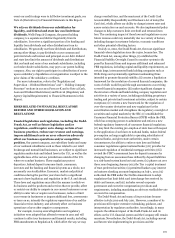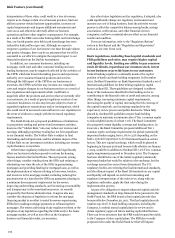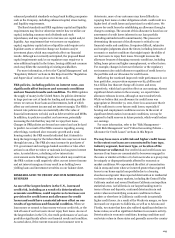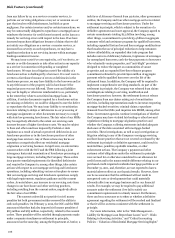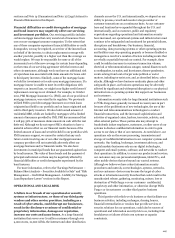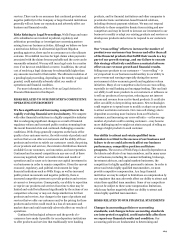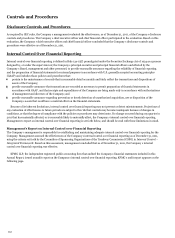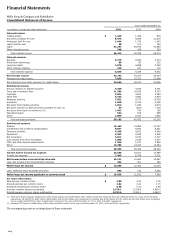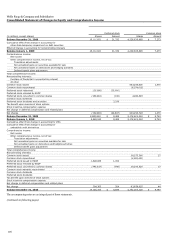Wells Fargo 2011 Annual Report Download - page 110
Download and view the complete annual report
Please find page 110 of the 2011 Wells Fargo annual report below. You can navigate through the pages in the report by either clicking on the pages listed below, or by using the keyword search tool below to find specific information within the annual report.Risk Factors (continued)
Although to date we have not experienced any material losses
relating to cyber attacks or other information security breaches,
there can be no assurance that we will not suffer such losses in
the future. Our risk and exposure to these matters remains
heightened because of, among other things, the evolving nature
of these threats, the prominent size and scale of Wells Fargo and
its role in the financial services industry, our plans to continue to
implement our Internet banking and mobile banking channel
strategies and develop additional remote connectivity solutions
to serve our customers when and how they want to be served, our
expanded geographic footprint and international presence, the
outsourcing of some of our business operations, the continued
uncertain global economic environment, and the remaining
system and customer account conversions associated with our
integration of Wachovia expected to be completed in first quarter
2012. As a result, cybersecurity and the continued development
and enhancement of our controls, processes and practices
designed to protect our systems, computers, software, data and
networks from attack, damage or unauthorized access remain a
priority for Wells Fargo. As cyber threats continue to evolve, we
may be required to expend significant additional resources to
continue to modify or enhance our protective measures or to
investigate and remediate any information security
vulnerabilities.
Disruptions or failures in the physical infrastructure or
operating systems that support our businesses and customers, or
cyber attacks or security breaches of the networks, systems or
devices that our customers use to access our products and
services could result in customer attrition, financial losses, the
inability of our customers to transact business with us, violations
of applicable privacy and other laws, regulatory fines, penalties
or intervention, reputational damage, reimbursement or other
compensation costs, and/or additional compliance costs, any of
which could materially adversely affect our results of operations
or financial condition.
Our framework for managing risks may not be effective
in mitigating risk and loss to us. Our risk management
framework seeks to mitigate risk and loss to us. We have
established processes and procedures intended to identify,
measure, monitor, report and analyze the types of risk to which
we are subject, including liquidity risk, credit risk, market risk,
interest rate risk, operational risk, legal and compliance risk, and
reputational risk, among others. However, as with any risk
management framework, there are inherent limitations to our
risk management strategies as there may exist, or develop in the
future, risks that we have not appropriately anticipated or
identified. For example, the recent financial and credit crisis and
resulting regulatory reform highlighted both the importance and
some of the limitations of managing unanticipated risks. If our
risk management framework proves ineffective, we could suffer
unexpected losses which could materially adversely affect our
results of operations or financial condition.
We may incur fines, penalties and other negative
consequences from regulatory violations, possibly even
inadvertent or unintentional violations. We maintain
systems and procedures designed to ensure that we comply with
applicable laws and regulations. However, some legal/regulatory
frameworks provide for the imposition of fines or penalties for
noncompliance even though the noncompliance was inadvertent
or unintentional and even though there was in place at the time
systems and procedures designed to ensure compliance. For
example, we are subject to regulations issued by the Office of
Foreign Assets Control (OFAC) that prohibit financial
institutions from participating in the transfer of property
belonging to the governments of certain foreign countries and
designated nationals of those countries. OFAC may impose
penalties for inadvertent or unintentional violations even if
reasonable processes are in place to prevent the violations. There
may be other negative consequences resulting from a finding of
noncompliance, including restrictions on certain activities. Such
a finding may also damage our reputation as described below
and could restrict the ability of institutional investment
managers to invest in our securities.
Negative publicity, including as a result of protests,
could damage our reputation and business. Reputation
risk, or the risk to our business, earnings and capital from
negative public opinion, is inherent in our business and
increased substantially because of the financial crisis and the
increase in our size and profile in the financial services industry
following our acquisition of Wachovia. The reputation of the
financial services industry in general has been damaged as a
result of the financial crisis and other matters affecting the
financial services industry, and negative public opinion about the
financial services industry generally or Wells Fargo specifically
could adversely affect our ability to keep and attract customers.
Negative public opinion could result from our actual or alleged
conduct in any number of activities, including mortgage lending
practices, servicing and foreclosure activities, corporate
governance, regulatory compliance, mergers and acquisitions,
and disclosure, sharing or inadequate protection of customer
information, and from actions taken by government regulators
and community or other organizations in response to that
conduct. Because we conduct most of our businesses under the
“Wells Fargo” brand, negative public opinion about one business
could affect our other businesses and also could negatively affect
our “cross-sell” strategy. The proliferation of social media
websites utilized by Wells Fargo and other third parties, as well
as the personal use of social media by our team members and
others, including personal blogs and social network profiles, also
may increase the risk that negative, inappropriate or
unauthorized information may be posted or released publicly
that could harm our reputation or have other negative
consequences, including as a result of our team members
interacting with our customers in an unauthorized manner in
various social media outlets.
During the past several months, Wells Fargo and other
financial institutions have been the targets of numerous protests
throughout the U.S., such as the “Occupy Wall Street” protests
and other movements designed to cause customers to close their
accounts with large financial institutions. These protests have
included disrupting the operation of our retail banking stores
and have resulted in negative public commentary about financial
institutions, including the fees charged for various products and
108





